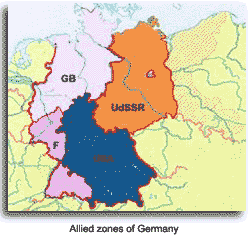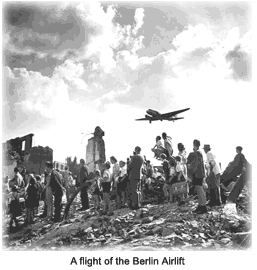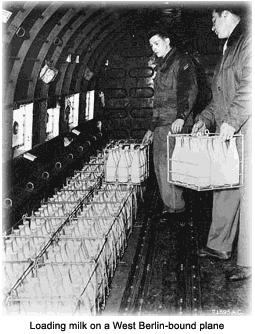Although a wartime alliance between the western democracies and the Soviet Union had united disparate governments in the effort to defeat Adolf Hitler, strains began to appear even before World War II was over. Within a few years, it was apparent that the Soviet Union had become America`s chief adversary instead of its ally.
While the war still raged, Walter Lippmann, a widely respected American newspaper columnist, wrote in a 1943 book entitled "U.S. Foreign Policy: Shield of the Republic":
Combined action of America, Britain, and Russia is the irreducible minimum guarantee of the security of each of them, and the only condition under which it is possible even to begin to establish any wider order of security.This was an outlook shared by many, for ideological as well as practical reasons. It was not easy after two world wars for the West to see Germany as a permanent ally or Russia as a permanent adversary, but the actions of Russia after World War II began to change their attitude. Stalin`s blockade of Berlin crystallized the situation and was a large factor in rehabilitating the image of the German people.
When Stalin imposed a land blockade of Berlin in June, 1948, in an attempt to take control of the city, the Allies responded with the Berlin Airlift and demonstrated their will and capacity to respond forcefully in the defense of their interests. At no time, except perhaps during the Cuban Missile Crisis, did the Cold War bring the world so close to hostilities between the major powers.
 The four major Allies — the United States, Great Britain, France, and the Soviet Union — had divided defeated Germany into zones of control. Its capital Berlin, far inside the Soviet zone of control, also was divided into four sectors.
The four major Allies — the United States, Great Britain, France, and the Soviet Union — had divided defeated Germany into zones of control. Its capital Berlin, far inside the Soviet zone of control, also was divided into four sectors.
Frustrated by their dealings with the Soviets, the United States and Great Britain concluded that they needed to improve the economy of their zones of Germany, simply to reduce the burden of keeping the population alive. The French declined to join them, so the two Anglo-Allies created the "bizone" in January 1947, which soon became known as "Bizonia.
The Soviet Union considered this to be a bilateral agreement that was prohibited by the Allies` wartime agreements. Relations between them and the Western Allies grew chillier throughout 1947 and the start of 1948.
As negotiations began to break down between the Western Allies and the Soviet Union, joint governance of Berlin ended on March 20, 1948, when the Soviet military governor, Marshall Sokolovsky, declared the Control Council had ceased to function. Acting as its chairman, he then adjourned the meeting and departed. Berlin’s Control Council did not meet again until after the fall of the Berlin Wall in November 1989.
On June 20, 1948, the three western Allies initiated currency reform in their sectors and replaced the old currency, the Reichmark, with a new one, the Deutsche Mark in an effort to improve the economy of their sectors and to wipe out the black market. Operation Bird Dog, as the mission was called, was a huge success.
The Soviet Union declared the currency replacement to be an unacceptable step toward the creation of a separate German state and banned all surface travel between Berlin and the Soviet zones of control on June 24 to keep the new currency from infiltrating into its sector. On the following day, the Royal Air Force began to fly in supplies for the British garrison in Berlin.
The military situation on the ground in Europe restricted the options available to the Western Allies. The Soviet army still maintained 17 divisions with thousands of tanks within Germany, while the huge American army that defeated Germany in 1945 had dwindled to 140,000 men.
In theory, one option was to send a military convoy that would force its way through Soviet territory to supply Berlin, but this was considered too likely to start a war that the West could not win. General Lucius Clay favored this option but was overruled.
Another option, urged by Winston Churchill, was to use the atomic bomb, at that time the exclusive property of the United States, to devastate the Soviet Union before it could develop one for itself. President Harry Truman, however, was unwilling to take that step, although to create a credible threat, he sent a number of B-27s to Britain, placing them within striking distance of major Soviet targets. The planes were widely assumed to be equipped with atomic bombs, although in fact they were not.
 The third option was to supply Berlin by air. The prospect of keeping a metropolis of two million alive with supplies brought entirely by air was daunting and many considered it impossible to achieve over an extended period of time.
The third option was to supply Berlin by air. The prospect of keeping a metropolis of two million alive with supplies brought entirely by air was daunting and many considered it impossible to achieve over an extended period of time.
Truman, however, would not consider a retreat from Berlin, so he ordered the third option to be put into effect. Although he publicly declared it would continue as long as necessary, he, like many others, expected a fairly quick resolution.
U.S. Air Force C-47 planes began to bring supplies into Berlin on June 26 for the mission unofficially called Operation Vittles. At that time, there were only two airfields in Berlin they could use: Templehof in the American sector and Gatow in the British, each with only one runway.
At the end of World War II, Templehof`s runway surface had been sod and restricted to fairly light aircraft. By June, 1948, it had been upgraded with a 12-foot rubber-based runway covered with steel landing mats. Construction of a second runway at Templehof began in July and a third later that year. An additional airfield at Tegel in the French sector was completed in only three months.
 Flights originated from two airfields in the American zone and one in the British. A precise timetable was established, with three minutes between landings at each airfield, around the clock. This allowed no room for error. If a plane could not land on its first attempt, it returned to its base in West Germany.
Flights originated from two airfields in the American zone and one in the British. A precise timetable was established, with three minutes between landings at each airfield, around the clock. This allowed no room for error. If a plane could not land on its first attempt, it returned to its base in West Germany.
The two primary needs were food and coal. Dry food was emphasized to achieve the greatest benefit for its weight. Since the Soviets had cut off electricity to West Berlin, coal was the only energy source for the beleaguered residents. The U.S. Air Force was responsible for the majority of tonnage and nearly all the coal.
In order to improve safety and cooperation between the U.S. and British airlift efforts, the Allies created the Combined Airlift Task Force under Major General William H. Tunner of the U.S. Air Force.
Tunner had been responsible for supplying U.S. forces in China from India with an airlift that crossed the "Hump" of the Himalayas. His deputy was Air Commodore G.W.F. Meren of the R.A.F. In October, the airlift averaged 4,760 tons of supplies daily, which exceeded the minimum for the first time. By spring, 400 planes were delivering 8,000 tons.
Despite early expectations that the dispute would be resolved quickly, the blockade and the airlift continued into 1949. In an attempt to demonstrate the futility of the Soviet tactics to them, General Tunner decided to establish a single day tonnage record at Easter. Between noon on Saturday and noon on Easter day, the airlift flew 1,398 sorties and brought in slightly less than 13,000 tons of supplies.
The Soviets eventually realized they were losing the propaganda battle. On May 12, 1949, they lifted the blockade of Berlin. The airlift nevertheless continued, gradually decreasing during the summer, until September 30, when the U.S. and Great Britain felt confident that the blockade would not be re-imposed.
 The statistics for the airlift are staggering. More than 550,000 sorties brought 500,000 tons of food and 1.5 million tons of coal, as well as newsprint for Berlin`s free press and seedlings to replace trees lost during the war.
The statistics for the airlift are staggering. More than 550,000 sorties brought 500,000 tons of food and 1.5 million tons of coal, as well as newsprint for Berlin`s free press and seedlings to replace trees lost during the war.
By comparison, the entire airlift to Sarajevo from 1992 to 1997 brought in 179,910 tons, less than the peak amount airlifted into Berlin in a single month. In addition, nearly 175,000 people were airlifted out, primarily children and tuberculosis patients.
Seventeen American and eight British aircraft crashed during the operation. A total of 70 British and American personnel lost their lives during the airlift and related operations.
The military outcome of the blockade and airlift reflected little change. The political landscape afterward, however, was completely redrawn. Even three years after the end of combat, the Germans and Allied troops had still regarded one another as occupied and occupier.
The airlift demonstrated to the Germans that the Western democracies would defend their freedoms. In turn, the soldiers of Great Britain and the United States began to see Germans as allies in the struggle against the Soviet Union in the Cold War. The genesis of the Western Alliance can be dated to the Berlin airlift.